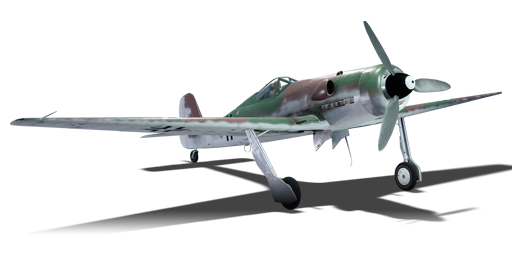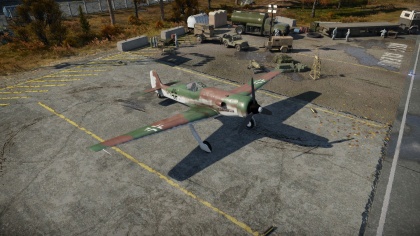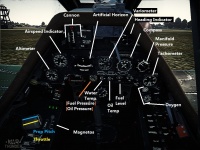Ta 152 H-1
Contents
| This page is about the German fighter Ta 152 H-1. For the other version, see Ta 152 C-3. |
Description
The Ta 152 H-1 is a rank IV German fighter
with a battle rating of 6.3 (AB), 6.0 (RB), and 5.7 (SB). This fighter has been in the game since the start of the Open Beta Test prior to Update 1.27.
General info
Flight Performance
The Ta-152H-1 is really fast, maneuverable and stable at +350 km/h. It is faster than most enemies at its BR, has a decent rate of climb, great turn time, and roll rate. You will easily climb faster than most competitors.
If you're going to play as an interceptor, just climb high and dive on bombers. In dogfights, do not neglect your combat flaps. .
| Characteristics | |||||||
|---|---|---|---|---|---|---|---|
| Stock | |||||||
| Max Speed (km/h at 10,200 m) |
Max altitude (meters) |
Turn time (seconds) |
Rate of climb (meters/second) |
Take-off run (meters) | |||
| AB | RB | AB | RB | AB | RB | ||
| 725 | 707 | 14800 | 21.1 | 21.3 | 14 | 14 | 315 |
| Upgraded | |||||||
| Max Speed (km/h at 10,200 m) |
Max altitude (meters) |
Turn time (seconds) |
Rate of climb (meters/second) |
Take-off run (meters) | |||
| AB | RB | AB | RB | AB | RB | ||
| 788 | 755 | 14800 | 20.3 | 20.5 | 22.2 | 17.5 | 315 |
Details
| Features | ||||
|---|---|---|---|---|
| Combat flaps | Take-off flaps | Landing flaps | Air brakes | Arrestor gear |
| ✓ | ✓ | ✓ | X | X |
| Limits | ||||
|---|---|---|---|---|
| Wing-break speed (km/h) |
Gear limit (km/h) |
Combat flaps (km/h) |
Max Static G | |
| + | - | |||
| 900 | ~10 | ~5 | ||
| Optimal velocities | |||
|---|---|---|---|
| Ailerons (km/h) |
Rudder (km/h) |
Elevators (km/h) |
Radiator (km/h) |
| < 380 | < 220 | < 550 | > 290 |
| Compressor (RB/SB) | ||
|---|---|---|
| Setting 1 | ||
| Optimal altitude | 100% Engine power | WEP Engine power |
| 2,000 m | 1,740 hp | 2,063 hp |
| Setting 2 | ||
| Optimal altitude | 100% Engine power | WEP Engine power |
| 6,200 m | 1,556 hp | 1,842 hp |
| Setting 3 | ||
| Optimal altitude | 100% Engine power | WEP Engine power |
| 9,100 m | 1,299 hp | 1,535 hp |
| Setting 4 | ||
| Optimal altitude | 100% Engine power | WEP Engine power |
| 12,200 m | 999 hp | 1,376 hp |
Survivability and armour
- 5 mm steel - under the cockpit
- 5 mm steel + 8 mm steel - behind the pilot
- 20 mm steel - pilot's headrest
- 70 mm bulletproof glass - armoured windscreen
- 15 mm steel - engine cowling
Armaments
Offensive armament
The Ta 152 H-1 is armed with:
- 1 x 30 mm MK 108 cannon, nose-mounted (90 rpg)
- 2 x 20 mm MG 151/20 cannons, wing-mounted (175 rpg = 350 total)
Usage in battles
The Ta-152 H-1 is a designated high altitude fighter with a great wing area and good manoeuvrability, unlike its heavier brethren the Ta 152 C-3. Fly high, preferably at >10 km (32000 ft) since the engine is more effective at those altitudes.
There is a noticeable change above 3,800 m where the engine starts providing more power however it is generally not sufficient to make the plane superior to the aircraft it generally fights, so do not rely on it. Most players use this aircraft as a "Boom & Zoom" although it is possible to dogfight with aircraft that have at least one disadvantage (e.g. P-51 - lower roll rate at low speeds and climb rate above 4,000 m relative to the Ta 152) so tactics vary.
Not advisable to tackle more than one enemy at once.
Do not dogfight Russian FW 190 D premium, or the Bearcat as there is practically nothing you can do.
Manual Engine Control
| MEC elements | ||||||
|---|---|---|---|---|---|---|
| Mixer | Pitch | Radiator | Supercharger | Turbocharger | ||
| Oil | Water | Type | ||||
| Not controllable | Controllable Auto control available |
Not controllable Auto control available |
Controllable Not auto controlled |
Combined | Not controllable 4 gears |
Not controllable |
Modules
| Tier | Flight performance | Survivability | Weaponry | ||
|---|---|---|---|---|---|
| I | Fuselage repair | Radiator | Offensive 20 mm | ||
| II | Compressor | Airframe | Offensive 30 mm | ||
| III | Wings repair | Engine | New 20 mm cannons | ||
| IV | Engine injection | Cover | New 30 mm cannons | ||
Pros and cons
Pros:
- 30 mm cannon usually obliterates enemies upon impact
- Stable in all axis (joystick)
- Unstable when ~400 km/h and turn(mouse aim)
- Can out-climb the P-51 D at high altitude
- Good performance above 7,000 m
- Combat flaps rip off at 900 km/h, which means you can use them in any speed
- Above average turner for Germany, combat flaps increase turn so much that you can keep up even with some Spitfires
- Excellent manoeuvring energy retention (MER), especially with flaps it will easily win a prolonged dogfight
Cons:
- 30 mm cannon is low-velocity, making it hard to hit
- Has a tendency to snap roll viciously
- Average roll rate, which is made significantly worse by pitching up/down
- Somewhat slow on low to medium altitude
- Poor parasite drag to thrust ratio, meaning a lot of energy is lost in diving attacks
- Very high repair cost for Realistic battles
History
Throughout much of World War II in Europe, the German Luftwaffe was only concerned with their aircraft flying in the mid to low altitudes (20,000 ft/6,100 m and below), therefore a majority of their fighter fleet only utilized a single-stage supercharger which was sufficient for their role. However, with the introduction of the B-29, the threat of this type of bomber would have been out of reach for most of the German air fleet.[1] To counter high-altitude allied fighters and bombers, the Fw 190D-9 was modified with a two-stage supercharged Junkers Jumo 213E engine which allowed it to achieve the higher altitudes, however, the shorter stubby wings well know for low altitude manoeuvrability actually hindered performance at altitude, though usable, not really a suitable fix.[2]
Answering the call of the German Air Ministry (RLM – Reichsluftfahrtministerium), Focke-Wulf modified their Fw 190 design and branched out in three directions. The three prototypes, in turn, had one to become the new existing Fw 190D (Ta 152A) series (after the D-9), the second prototype would become a dedicated high-altitude bomber (Ta 152B) while the third would become a ground-attack aircraft (Ta 152H).[2] Though adjustments and modifications were made including usage of a different engine, the ultimate results determined these aircraft did not provide enough improvement to continue moving forward and both the Ta 152A and B projects were cancelled. One bright spot from this was that the airframe built for the Ta 152B (the V21 airframe) showed promise and efforts were focused here to create the Ta 152C prototype.
In 1944 the RLM made a ruling that new fighter aircraft were to include the chief designer's name in the aircraft’s designation. What was earlier knows as a Focke-Wulf aircraft was now listed with the prefix Ta which was short for Kurt Tank, though Tank was still working for Focke-Wulf at the time.
Adjustments to the Fw 190D-9 fuselage resulted in its extension and addition of hydraulics to control the flaps and landing gear. These adjustments threw off the normal centre of gravity and made the aircraft off balance, resulting in the lengthening of the nose of the aircraft to normalize the CoG. The length of the wings was slightly lengthened and due to shortages in aluminium, steel spars were utilised aiding to the strength of the wings, but also at a price of extra weight.[2]
- Ta 152C variant
The Ta 152C-3 ended up with wings .5 m (1.25 ft) longer than the standard Fw 190D-9 to aid in supporting the new steel spars and hydraulic hardware in the landing gear and flaps. The 'C' variant did not incorporate a pressurized cockpit. While designed to work at lower altitudes (though above 25,000 ft or 6,100 m), the fighter was outfitted with a single 30 mm MK 108 Motorkanone which was mounted through the center propeller hub with four MG 151/20 mm cannons, two of which were mounted in the upper fuselage and two more with one in each wing.[1] This cannon setup is enough to devastate any aircraft which is on the receiving end of the 20 and 30 mm rounds. The Ta 152C-3 entered the war too late and in too little numbers to make an effective difference. Shortages in replacement parts became extremely difficult if not impossible to find reducing the ability of the Ta 152C-3 to be used to the fullest of its abilities.[2]
- Ta 152H variant
The Ta 152H-1 was refined to be more of a high-altitude fighter even so over the Ta 152C. Wings were extended a full length of 14.4 m (47.4 ft), though this lowered its overall speed, it provided substantial improvement with high-altitude handling. To aid the pilots in the higher altitude flights, the H variant was outfitted with a pressurized cockpit. The cockpit was pressurized to approximately a level comparable with 8,000 m (26,250 ft) and the canopy was comprised of two layers of which the outer was a thicker material with a thinner inner pane. To compensate for any moisture which could form between the panes, silica gel was added to aid in stemming any fogging. Unlike the ‘C’ variant, the ‘H’ only utilised a single 30 mm MK 108 Motorkanone firing through the propeller hub along with just two MG 151/20 mm autocannons, both of which were mounted in the upper fuselage. Eliminating the two wing-mounted cannons aided in increased manoeuvrability and less weight to make up for some of the additional weight added due to the pressurized cockpit system.
Overall the Ta 152H variant was one of the fastest piston-engine fighters to emerge during World War II, cruising around 750 kph (465 mph) while at around 10,200 m (33,000 ft). The Ta 152H also employed the usage of GM-1 nitrous oxide boost and MW 50 methanol-water boost to briefly increase performance in the aircraft and if necessary, both could be applied at the same time.[1]
In-game description
"The Ta 152 was, without a doubt, the best aircraft designed by Kurt Tank for Focke-Wulf. The aircraft was a further redesign of the venerable Fw 190, namely of the Fw 190 D. The Ta 152 became possible thanks to the new high-altitude Jumo 213 and DB 603 engines.
Development began in the winter of 1942-1943, when RLM's technical department released specifications for a new 'Spezial Jaeger', or Special Fighter. The fighter was to be capable of a high-altitude interceptor role. The Ta 152 H-1 was armed with a MK 108 cannon with 85 rounds firing through the propeller hub and two MG 151/20 cannons (220 rounds per gun) in the wings. The H-1 went into serial production in January or February of 1945. A total of only 70 or so were produced, of which very few made it to front-line service."
Media
- Videos
See also
- Related development
- Focke-Wulf Fw 190
- Aircraft of comparable role, configuration and era
External links
References
- ↑ 1.0 1.1 1.2 Jack, C. (2019, January 21). Focke-Wulf Ta 152 Single-Seat, Single-Engine High-Altitude Fighter-Interceptor Aircraft - Nazi Germany. Retrieved from https://www.militaryfactory.com/aircraft/detail.asp?aircraft_id=455.
- ↑ 2.0 2.1 2.2 2.3 Focke-Wulf Ta 152C. (n.d.). Retrieved from http://www.historyofwar.org/articles/weapons_focke-wulf_Ta_152C.html.
| Focke-Wulf Aircraft Corporation (Focke-Wulf Flugzeugbau Aktiengesellschaft) | |
|---|---|
| Fighters | Fw 190 A-1 · Fw 190 A-4 · Fw 190 A-5 · Fw 190 A-5/U2 · Fw 190 A-5/U12 · Fw 190 A-5/U14 · Fw 190 A-8 |
| Fw 190 C | |
| Fw 190 D-9 · Fw 190 D-12 · Fw 190 D-13 | |
| Fw 190 F-8 | |
| Ta 152 C-3* · Ta 152 H-1* · Ta 154 A-1* | |
| Bombers | Fw 189 A-1 · Fw 200 C-1 |
| Export | ▅Fw 190 A-5 |
| Captured | ▃Fw 190 A-8 · ▂Fw 190 D-9 |
| * In 1944, the Germany Air Ministry changed new fighter aircraft designation to that of the chief designer. Kurt Tank was the chief designer at Focke-Wulf and later aircraft he designed were given the prefix of Ta. | |
| Germany fighters | |
|---|---|
| Heinkel | |
| He 51 | He 51 A-1 · He 51 B-1 · He 51 B-2/H · He 51 C-1 · He 51 C-1/L |
| He 100 | He 100 D-1 |
| He 112 | He 112 A-0 · He 112 B-0 · He 112 B-1/U2 · He 112 B-2/U2 · He 112 V-5 |
| Messerschmitt | |
| Bf 109 (Jumo) | Flegel's Bf 109 A · Bf 109 B-1 · Bf 109 C-1 · Bf 109 C-1 |
| Bf 109 (DB-601) | Bf 109 E-1 · Bf 109 E-3 · Bf 109 E-4 · Bf 109 E-7/U2 · Bf 109 F-1 · Bf 109 F-2 · Bf 109 F-4 · Bf 109 F-4/trop |
| Bf 109 (DB-605) | Bf 109 G-2/trop · Bf 109 G-2 · Bf 109 G-6 · Bf 109 G-10 · Bf 109 G-14 · Bf 109 K-4 |
| Focke-Wulf | |
| Fw 190 (early) | Fw 190 A-1 · Fw 190 A-4 · Fw 190 A-5 · Fw 190 A-5 · Fw 190 A-5/U2 · Fw 190 A-5/U14 · Fw 190 A-8 · Fw 190 C |
| Fw 190 (late) | Fw 190 D-9 · Fw 190 D-12 · Fw 190 D-13 |
| Ta 152 | Ta 152 C-3 · Ta 152 H-1 |
| Blohm & Voss | |
| BV 155 | BV 155 B-1 |
| Captured: | |
| USA | ▀P-47D-16-RE · ▀P-47D |
| USSR | ▀La-5FN · ▀Yak-1B |
| Britain | ▀Tempest Mk V |
| Italy | |
| CR.42 | ▀CR.42 · ▀Marcolin's C.R.42 CN |
| G.50 | ▀G.50 serie 2 · ▀G.50 AS serie 7 |
| C.200 | ▀C. 200 serie 3 · ▀C. 200 serie 7 |
| C.202 | ▀C. 202 |
| Finland | ▀Hawk H-75A-2 |






